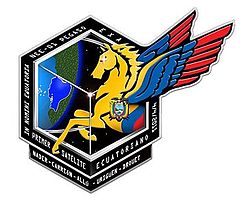- NEE-01 Pegasus
-
NEE-01 Pegasus[1] Is the first Ecuadorian satellite, built by the Ecuadorian Space Agency and presented officially in April 4, 2011
NEE-01 PEGASUS 
Operator  Ecuador Ecuadorian Civilian Space Agency
Ecuador Ecuadorian Civilian Space AgencyMission type Scientific/Technology Demonstration/Education Satellite of Earth Orbits Low Earth orbit Launch date 2012 Homepage pegaso.exa.ec Mass 1200 grams The NEE-01 PEGASUS is a nano satellite, of the cubesat 1U class, it has a cubic shape and two solar panel wings with 3 panels on each side for a total of 6 panels per wing, its dimensions are 10 by 10 by 75 centimeters (4 by 4 by 30 inches) with its solar wings completely deployed and weights 1.2 kilos,[2] it has an on-board dual visible and infrared camera which will allow the spacecraft to take pictures and transmit live video from space, the launch into orbit is planned for the 3rd quarter of year 2012 on board a Russian rocket.
Contents
Construction
The satellite was completely designed and built in the country, without any foreign assistance, by an EXA engineering team led by Cmdr. Ronnie Nader and engineers Sidney Drouet, Manuel Uriguen, Héctor Carrión, Ricardo Allú and Gonzalo Naranjo, the project took almost 2 years since its conception in April 2009 and the building of the spacecraft took a year in the EXA laboratory. Besides the live video signal, the spacecraft will send a constant radio signal that will act as a beacon, consisting in its identification and the Ecuador’s national anthem.[3]
The satellite will be operated from the HERMES-A/MINOTAUR ground station of the EXA in Guayaquil.
Objectives
- Technology Demonstration: For new low cost nano satellite technologies
- Scientific Research: On LEO environment and its relation to spacecraft navigation
- Education: For serving as an space-based platform for elemental education
- Capability Building: To build a national satellite building industry basis
Missions
Primary mission: National Technology testing
- Survive the LEO space environment and transmit telemetry for at least a year
- Transmit live video feed from orbit and On-Screen telemetry
- Test the Space Environment Attenuation Manifold NEMEA
- Test the passive release/deploy technology on multi phase nano solar arrays
- Test the high energy generation technology for small spacecraft
- Test the ARGOS-MINOTAUR hyper amplification matrix
Secondary Mission: Space based education platform
- Serve as space based education platform for elementary levels
- Demonstrate the benefits of an education satellite
- Inspire the need for research and self education in the young population
- Transmit the Ecuador's national anthem from space
The satellite’s primary mission is to test the basic and key technologies that will allow the EXA to build bigger and more powerful spacecraft in the future and the secondary mission is to serve as a space platform for elementary education: The satellite will send two signals that will be received and decoded by the EXA’s HERMES-A ground station in Guayaquil and then uploaded live to the Internet using Twitter and Facebook; the first signal will contain text book questions and the second will contain an image related to the question. If the students are able to answer the question correctly they will be granted access to the video camera on board the spacecraft and will be able to see earth from space as the astronauts see it in their space missions. More advanced students will have access to the pure radio signal so they can try decoding it by themselves.
Technology
- CYCLOPS: This module manages the radio transceiver, the real time video system and the telemetry processing, the camera transmit in 520 lines of resolution[4]
- NEREIDA: This system is responsible for transmitting the data for the education missions and the national anthem.
- PMSS: The spacecraft's navigation system, it uses the earth's magnetic field to acquire attitude control using a Neodymium nucleus and inertial damping breaks made of Samarium and Cobalt
- SEAM/NEMEA: Its mission is to damp the space environment variables, reducing the incoming temperature and the alpha, beta, X and gamma radiation, without producing secondary radiation.[5]
- DSA: Managed the release and deploy of the multi phase solar arrays, made of 99.98% pure titanium, each panel measures 1.5mm thick and they reach 27 cms once fully deployed, it uses memory shape alloys and solar radiation to be automatically activated.[6]
- EPS: Using 32 intelligent batteries for a total of 28.8 amperes.[7]
- ADS: Automatically Deploys the dipole antenna using solar radiation.[8]
- NTDS: The thermal distribution system uses multi-wall carbon nanotubes to distribute the internal and external heat over the spacecraft during the eclipse phase[9]
The satellite carries many advanced technologies which by themselves are firsts for this kind of spacecraft: It is the first known cubesat 1U to be equipped with a live video transmission system, is the first of its kind in being equipped with a multilayer shield composed by polymers and alloys that allows the spacecraft to withstand solar flares and other space hazards, it is the first known to have a thermal stabilization system based in carbon nanotubes, it has the thinnest known solar arrays for this cubesat 1U class, measuring only 1.5 millimeters thick, made of 99.98% pure titanium, also it has the biggest power matrix ever carried by a 1U cubesat with 28.8 amperes of total installed capacity in a volume of only 200 cubic centimeters.
See also
External links
- Ecuadorian Civilian Space Agency Guayaquil, Ecuador.
- NEE-01 PEGASUS satellite official website.
- Official press release
- NEE-01 PEGASUS official paper - IAC2011
- Mike Rupprecht site reference
References
- ^ http://www.exa.ec/trabajos/10055-1.pdf
- ^ http://exa.ec/bp37
- ^ http://pegaso.exa.ec
- ^ http://www.exa.ec/trabajos/10060-1.pdf
- ^ http://www.exa.ec/trabajos/10064-1.pdf
- ^ http://www.exa.ec/trabajos/10058.pdf
- ^ http://www.exa.ec/trabajos/10068.pdf
- ^ http://www.exa.ec/trabajos/10066.pdf
- ^ http://www.exa.ec/trabajos/10063.pdf
Categories:- CubeSats
- Science and technology in Ecuador
Wikimedia Foundation. 2010.

